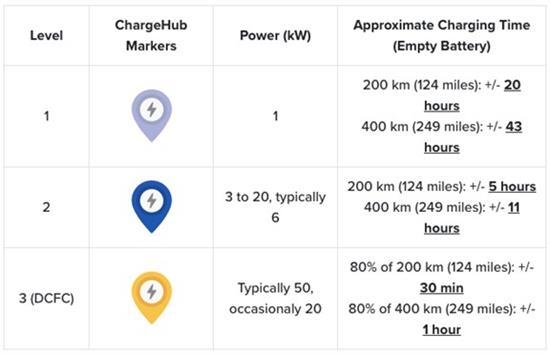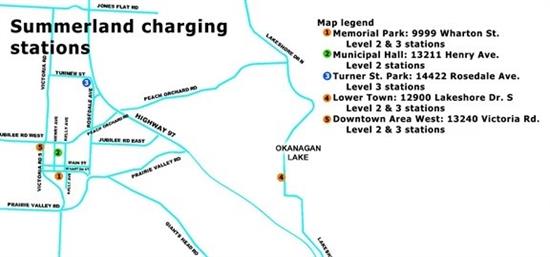
Learn About Charging Electric Vehicles
Getting Started
Most fully electric vehicles (EVs) have a range of over 350 kilometres per charge. For battery health, it’s typically recommended drivers charge to about 80% and don't run down the battery to zero. When it comes time to charge, there are many charging stations available, including chargers at 5 convenient locations throughout Summerland.
For a map of all available public chargers, visit a website such as ChargeHub or PlugShare or download their app. You can filter for specific types of chargers, find out the details of a specific charging site, and view feedback from other drivers.
A Better Route Planner is an app that calculates the best places for you to charge based on your vehicle type and your destination. It will also estimate how long it will take you to get where you’re going and how much it will cost. You can change options for weather, road conditions, and more.
All chargers in B.C. (in addition to Tesla) are on the FLO, Chargepoint, BC Hydro, or Greenlots network. Summerland‘s chargers are on the FLO network and using the FLO app or RFID card is recommended; however, an RFID card from any EV network will work at our stations.
To begin a session, you can use a smartphone app or you can also get an RFID card, which you can order via their mobile app or using their website. Using an RFID card makes the charging process quick and easy with a swipe of the card. They cost around $15 each and many drivers choose to carry cards for multiple networks in the car to make it easy to start charging at any location.
Types of Chargers
As infrastructure constantly expands around B.C., Level 3 chargers are now rarely more than 100km apart. The time it takes to recharge depends on the battery size of your EV and what type of charging station you are using. There are three levels of charging stations based on the speed of their charge.

Level 1 charger (also known as a trickle charge): This is your typical wall outlet with 120V. This is the slowest charger and many EV owners plug into these for an overnight charge or while they are at work. It charges about 8 kilometres of range per hour.
Level 2 charger (also called slow or AC chargers): These are the most common type of charger. They're found at malls and community centres — places where you can leave your car for an extended period of time. Many EV owners also install this type of charger at home (they are the same outlet as an electric stove/oven) and there are often rebates available to do so. They typically take over three hours for a full charge, adding about 40 kilometres of range per hour.
Level 3 charger (called fast chargers or DCFCs – Direct Current Fast Charger or in the case of Tesla, a Supercharger): These typically take about 30 minutes for a nearly full charge (most EVs won’t let the car go past 80% on a fast charger as it can damage the battery). These are less common as they are harder on the battery but they are gaining popularity for convenience.
Charging Compatibility
With the appropriate adapter, you can charge at most stations.
Tesla vehicles have their own type of plug and use Tesla’s Supercharger stations. Non-Tesla EVs cannot be charged at Tesla chargers without purchasing a special adapter that works only at Tesla Destination Chargers, which are Level 2. Tesla EVs can use non-Tesla chargers with the J1772 adapter, which typically comes with a Tesla on purchase.
All electric vehicles in Canada can use a standard J-plug charging station (Teslas come with an adapter) for Level 2 charging. These are found at homes, workplaces, community centres, malls, and parks.
Some EVs come with Level 2 charging cables and all EVs come with Level 1 charging cables.
For Level 3 fast charging, the CHAdeMO and SAE Combo (also called CCS for “Combo Charging System”) are the most used connectors by electric cars manufacturers. Summerland’s Level 3 chargers offer both of these types of plug.
For a comprehensive understanding about chargers and compatibility, check out ChargeHub's webpage.
Charging Etiquette
There is some etiquette that EV owners should abide by for the consideration of others.
1. When you‘re done, put the charging cord away so people don‘t trip or drive over it. And please keep the station tidy.
2. If you are at a Fast Charger (Level 3), consider limiting your charging time to around 30 minutes. Your charging speed will slow down anyway as you get closer to full. Fast Chargers are the most popular and not taking too long is courteous to others who are likely waiting.
3. You don‘t have to stay at your car while charging but do monitor the status through your charging app, and move your vehicle once finished.
4. Don‘t unplug others, unless there is a note that gives you permission to do so.
Fees
The price for charging varies from location to location. How much it will cost you to recharge is dependent on the fees at the particular station, your state of charge when you arrive, and how big your car's battery is.
In Summerland, the 2021 fees for public charging are:
$2/hour for Level 2 chargers
$18/hour for Level 3 chargers
Summerland's EV Chargers
Summerland has five charging station locations, each with Level 2 and/or Level 3 stations available.

Using Summerland’s chargers is easy. Watch the video below for more information:
You can also check out our brochure Summerland's EV Chargers - What You Need to Know. Printed copies are available at Municipal Hall.